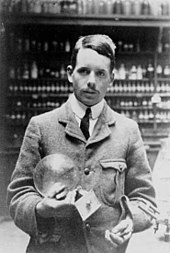
Moseley's law is an empirical law concerning the characteristic X-rays emitted by atoms. The law had been discovered and published by the English physicist Henry Moseley in 1913–1914. Until Moseley's work, "atomic number" was merely an element's place in the periodic table and was not known to be associated with any measurable physical quantity. In brief, the law states that the square root of the frequency of the emitted X-ray is approximately proportional to the atomic number:
History

The historic periodic table was roughly ordered by increasing atomic weight, but in a few famous cases the physical properties of two elements suggested that the heavier ought to precede the lighter. An example is cobalt having the atomic weight of 58.9 and nickel having the atomic weight of 58.7.
Henry Moseley and other physicists used X-ray diffraction to study the elements, and the results of their experiments led to organizing the periodic table by proton count.
Apparatus
Since the spectral emissions for the lighter elements would be in the soft X-ray range (absorbed by air), the spectrometry apparatus had to be enclosed inside a vacuum. Details of the experimental setup are documented in the journal articles "The High-Frequency Spectra of the Elements" Part I and Part II.
Results
Moseley found that the lines (in Siegbahn notation) were indeed related to the atomic number, Z.
Following Bohr's lead, Moseley found that for the spectral lines, this relationship could be approximated by a simple formula, later called Moseley's Law. where:
- is the frequency of the observed X-ray emission line
- and are constants that depend on the type of line (that is, K, L, etc. in X-ray notation)
- Rydberg frequency and = 1 for lines, and Rydberg frequency and for lines.
Derivation
Moseley derived his formula empirically by fitting the square root of the X-ray frequency plotted against the atomic number. This formula can be explained based on the Bohr model of the atom, namely, where
- is the permittivity of free space
- is the mass of an electron
- is the charge of an electron
- is an effective charge of the nucleus, expressed as
- is the quantum number of final energy level
- is the quantum number of initial energy level ()
- is the Planck constant
Taking into account the empirically found b constant that reduced (or "screened") the nucleus charge, Bohr's formula for transitions becomes Dividing both sides by h to convert to the frequency units, one obtains
Screening
A simplified explanation for the effective charge of a nucleus being one less than its actual charge is that an unpaired electron in the K-shell screens it. An elaborate discussion criticizing Moseley's interpretation of screening can be found in a paper by Whitaker which is repeated in most modern texts.
A list of experimentally found and theoretically calculated X-ray transition energies is available at NIST. Nowadays, theoretical energies are computed with much greater accuracy than Moseley's law allows, using modern computational models such as the Dirac–Fock method (the Hartree–Fock method with the relativistic effects accounted for).
See also
- Moseley's periodic law, concerning the modern periodic table.
- Auger electron spectroscopy, a similar phenomenon with increased X-ray yield from species of higher atomic number.
- Discovery of the neutron Mosley's law was an important step in the development of the understanding of the atom.
References
- ^ Moseley, Henry G. J. (1913). "The High-Frequency Spectra of the Elements". The London, Edinburgh and Dublin Philosophical Magazine and Journal of Science. 6. 26. Smithsonian Libraries. London-Edinburgh: London : Taylor & Francis: 1024–1034. doi:10.1080/14786441308635052.
- ^ Moseley, Henry G. J. (1914). "The High-Frequency Spectra of the Elements. Part II". Philosophical Magazine. 6. 27: 703–713.
- e.g. Mehra, J.; Rechenberg, H. (1982). The historical development of quantum theory. Vol. 1, Part 1. New York: Springer-Verlag. pp. 193–196. ISBN 3-540-90642-8.
- Bragg, W. H. (1915). X Rays and Crystal Structure. G. Bell and Sons, Ltd. pp. 75–87.
- K. R. Naqvi (1996). "The physical (in)significance of Moseley's screening parameter". American Journal of Physics. 64 (10): 1332. Bibcode:1996AmJPh..64.1332R. doi:10.1119/1.18381.
- A. M. Lesk (1980). "Reinterpretation of Moseley's experiments relating K alpha line frequencies and atomic number". American Journal of Physics. 48 (6): 492–493. Bibcode:1980AmJPh..48..492L. doi:10.1119/1.12320.
- Whitaker, M. A. B. (1999). "The Bohr–Moseley synthesis and a simple model for atomic X-ray energies". European Journal of Physics. 20 (3): 213–220. Bibcode:1999EJPh...20..213W. doi:10.1088/0143-0807/20/3/312. S2CID 250901403.
- "NIST X-ray Transition Energies Database".
External links
- Oxford Physics Teaching - History Archive, "Exhibit 12 - Moseley's graph Archived 2016-03-03 at the Wayback Machine" (Reproduction of the original Moseley diagram showing the square root frequency dependence)
| X-ray science | |||||||||
|---|---|---|---|---|---|---|---|---|---|
| Characteristics | |||||||||
| Sources and instruments | |||||||||
| Interaction with matter | |||||||||
| Applications |
| ||||||||

 lines (in
lines (in  where:
where:
 is the frequency of the observed X-ray emission line
is the frequency of the observed X-ray emission line and
and  are constants that depend on the type of line (that is, K, L, etc. in X-ray notation)
are constants that depend on the type of line (that is, K, L, etc. in X-ray notation)
 = 1 for
= 1 for 
 for
for  lines.
lines. where
where
 is the
is the  is the
is the  is the
is the  is an effective charge of the nucleus, expressed as
is an effective charge of the nucleus, expressed as 
 is the quantum number of final energy level
is the quantum number of final energy level is the quantum number of initial energy level (
is the quantum number of initial energy level ( )
) is the
is the  Dividing both sides by h to convert to the frequency units, one obtains
Dividing both sides by h to convert to the frequency units, one obtains
